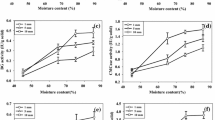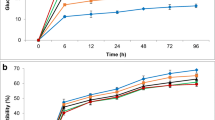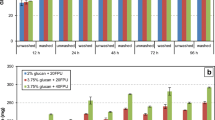Abstract
Oilseed plants such as cotton (Gossypium sp.) generate abundant biomass residues which contain significant levels of edible oil, crude proteins and other desirable biomolecules for the animal nutrition industry. The application of cottonseed cake in animal feed, a by-product of the cotton industry, is limited due to the natural presence of toxic free gossypol (FG), wherein efficient and cost-effective methods for FG detoxification are necessary. Herein, pretreatment methods for reducing FG in crushed whole cottonseed (CWCS) were compared, with residual FG quantified using a sensitive Ultra High-Performance Liquid Chromatography method for detection at trace levels in cottonseed materials. Physical treatment by autoclaving resulted in up to 96% detoxification of FG, without reduction in crude protein (CP) content. Chemical treatment with 1% and 2% Ca(OH)2 eliminated FG to as low as 0.04%, although a reduction in CP content was observed. Similarly, native fermentation, whilst reducing FG content by 99.66% after 6 days incubation, also reduced CP content. In combined physical and biological solid-state fermentation (SSF), basidiomycete fungi Ganoderma lucidum CC351, Panus lecomtei CC40, Pleurotus ostreatus CC389, Pleurotus sapidus CC28 and Pycnoporus sanguineus CC400 all degraded FG in autoclaved CWCS to trace levels often lower than obtained by individual treatments. A reduction in total lipids and increase in CP were also observed, improving nutritional quality. The most efficient fungi, P. ostreatus CC389 and P. lecomtei CC40, secreted considerable laccase and manganese peroxidase enzymes during SSF, potentially involved in FG detoxification. Cost effective, non-polluting, value-adding approaches for FG detoxification offer potential in animal feed industries.
Graphic Abstract





Similar content being viewed by others
Data Availability
Sequences enabling molecular identification were deposited in GenBank (https://www.ncbi.nlm.nih.gov) under accession numbers MK603977, MK603978, MK603976, MK603979 and MK603975.
References
Mena, H., Santos, J.E.P., Huber, J.T., Tarazon, M., Calhoun, M.C.: The effects of varying gossypol intake from whole cottonseed and cottonseed meal on lactation and blood parameters in lactating dairy cows. J. Dairy Sci. 87(8), 2506–2518 (2004)
Stipanovic, R.D., Lopez, J.D., Dowd, M.K., Puckhaber, L.S., Duke, S.E.: Effect of racemic and (+)-and (−)-gossypol on the survival and development of Helicoverpa zea larvae. J. Chem. Ecol. 32(5), 959–968 (2006)
Dalle Zotte, A., Brand, T.S., Hoffman, L.C., Schoon, K., Cullere, M., Swart, R.: Effect of cottonseed oilcake inclusion on ostrich growth performance and meat chemical composition. Meat Sci. 93(2), 194–200 (2013)
Puckhaber, L.S., Zheng, X., Bell, A.A., Stipanovic, R.D., Nichols, R.L., Liu, J., Duke, S.E.: Differences in active defense responses of two gossypium barbadense L. cultivars resistant to Fusarium oxysporum f. sp. vasinfectum Race 4. J. Agric. Food Chem. 66(49), 12961–12966 (2018)
Calhoun, M.C., Kuhlmann, S.W., Baldwin. B.C.: Assessing the gossypol status of cattle fed cottonseed products. In: Proceedings of the Pacific Northwest Animal Nutrition Conference, pp. 147A–157A, Portland, OR (1995)
Noftsger, S.M., Hopkins, B.A., Diaz, D.E., Brownie, C., Whitlow, L.W.: Effect of whole and expanded-expelled cottonseed on milk yield and blood gossypol. J. Dairy Sci. 83, 2539–2547 (2000)
Blackwelder, J.T., Hopkins, B.A., Diaz, D.E., Whitlow, L.W., Brownie, C.: Milk production and plasma gossypol of cows fed cottonseed and oilseed meals with or without rumen-undegradable protein. J. Dairy Sci. 81, 2934–2941 (1998)
Alexander, J., Andersson, H.C., Bernhoft, A., Brimer, L., et al.: Gossypol as undesirable substance in animal feed. EFSA J. 908, 1–55 (2008)
Knutsen, H.K., Barregård, L., Bignami, M., Brüschweiler, B., et al.: Presence of free gossypol in whole cottonseed. Scientific opinion of the panel on contaminants in the food chain (CONTAN). EFSA J. 15, e048501 (2017)
Gadelha, I.C.N., Fonseca, N.B.S., Oloris, S.C.S., Melo, M.M., Soto-Blanco, B.: Gossypol toxicity from cottonseed products. Sci. World J. 2014, 231635 (2014)
Atia, A.I., Abdel-Rahim, G.A.: Detoxification treatments of free gossypol in cottonseed meal by microbial treatment of mixed cultures and biochemical evaluation on rabbits. J. Rad. Res. Appl. Sci. 2(2), 397–415 (2009)
Zhang, Y., Zhang, Z., Dai, L., Liu, Y., Cheng, M., Chen, L.: Isolation and characterization of a novel gossypol-degrading bacteria Bacillus subtilis strain Rumen Bacillus subtilis. Asian-Australas. J. Anim. Sci. 31(1), 63 (2018)
Nomeir, A., Abou-Donia, M.: Photodecomposition of gossypol by ultraviolet irradiation. J. Am. Oil Chem. Soc. 62, 87–89 (1985)
Gerasimidis, K., Fillou, D.T., Babatzimcpoulou, M., Tassou, K., Katsikas, H.: Preparation of an edible cottonseed protein concentrate and evaluation of its functional properties. Int. J. Food Sci. Nutr. 58(6), 486–490 (2007)
Wang, X., Howell, C.P., Chen, F., Yin, J., Jiang, Y.: Gossypol-a polyphenolic compound from cotton plant. Adv. Food Nutr. Res. 58, 215–263 (2009)
Nagalakshmi, D., Sastry, V.R.B., Agrawal, D.K.: Detoxification of undecorticated cottonseed meal by various physical and chemical methods. Anim. Nutr. Feed Technol. 2(2), 117–126 (2002)
Nagalakshmi, D., Sastry, V.R.B., Pawde, A.: Rumen fermentation patterns and nutrient digestion in lambs fed cottonseed meal supplemental diets. Anim. Feed Sci. Technol. 103(1), 1–14 (2003)
Buser, M.D., Abbas, H.K.: Mechanically processing cottonseed to reduce gossypol and aflatoxin levels. J. Toxicol. Toxin Rev. 20(3–4), 179–208 (2001)
Zhang, W.J., Xu, Z.R., Sun, J.Y., Yang, X.: Effect of selected fungi on the reduction of gossypol levels and nutritional value during solid substrate fermentation of cottonseed meal. J. Zhejiang Univ. Sci. B 7(9), 690–695 (2006)
Zhang, W.J., Xu, Z.R., Zhao, S.H., Jiang, J.F., Wang, Y.B., Yan, X.H.: Optimization of process parameters for reduction of gossypol levels in cottonseed meal by Candida tropicalis ZD-3 during solid substrate fermentation. Toxicon 48(2), 221–226 (2006)
Lim, S.J., Lee, K.J.: A microbial fermentation of soybean and cottonseed meal increases antioxidant activity and gossypol detoxification in diets for Nile tilapia Oreochromis niloticus. J. World Aquac. Soc. 42(4), 494–503 (2011)
Kulikova, N.A., Klein, O.I., Stepanova, E.V., Koroleva, O.V.: Use of basidiomycetes in industrial waste processing and utilization technologies: fundamental and applied aspects. Appl. Biochem. Microbiol. 47(6), 565 (2011)
Rajarathnam, S., Shashirekha, M.N., Bano, Z.: Biodegradation of gossypol by the white oyster mushroom, Pleurotus florida, during culturing on rice straw growth substrate, supplemented with cottonseed powder. World J. Microb. Biotechnol. 17(3), 221–227 (2001)
Fackler, K., Gradinger, C., Hinterstoisser, B., Messner, K., Schwanninger, M.: Lignin degradation by white rot fungi on spruce wood shavings during short-time solid-state fermentations monitored by near infrared spectroscopy. Enzyme Microb. Technol. 39(7), 1476–1483 (2006)
Conceição, A.A., Soares Neto, C.B., Ribeiro, J.A., Siqueira, F.G., Miller, R.N., Mendonça, S.: Development of an RP-UHPLC-PDA method for quantification of free gossypol in cottonseed cake and fungal-treated cottonseed cake. PLoS ONE 13(5), e0196164 (2018)
Gardes, M., Bruns, T.D.: ITS primers with enhanced specificity for basidiomycetes-application to the identification of mycorrhizae and rusts. Mol. Ecol. 2(2), 113–118 (1993)
Menolli Junior, N., Asai, T., Capelari, M., Paccola-Meirelles, L.D.: Morphological and molecular identification of four Brazilian commercial isolates of Pleurotus spp. and cultivation on corncob. Braz. Arch. Biol. Technol. 53(2), 397–408 (2010)
Liu, Y.J., Whelen, S., Hall, B.D.: Phylogenetic relationships among ascomycetes: evidence from an RNA polymerse II subunit. Mol. Biol. Evol. 16(12), 1799–1808 (1999)
Matheny, P.B., Wang, Z., Binder, M., Curtis, J.M., Lim, Y.W., Nilsson, R.H., Langer, E.: Contributions of rpb2 and tef1 to the phylogeny of mushrooms and allies (Basidiomycota, Fungi). Mol. Phylogenet. Evol. 43(2), 430–451 (2007)
Kumar, S., Stecher, G., Tamura, K.: MEGA7: molecular evolutionary genetics analysis version 7.0 for bigger datasets. Mol. Biol. Evol. 33(7), 1870–1874 (2016)
Wolfenden, B.S., Willson, R.L.: Radical-cations as reference chromogens in kinetic studies of ono-electron transfer reactions: pulse radiolysis studies of 2, 2′-azinobis-(3-ethylbenzthiazoline-6-sulphonate). J. Chem. Soc. Perkin Trans. 2, 805–812 (1982)
Kuwahara, M., Glenn, J.K., Morgan, M.A., Gold, M.H.: Separation and characterization of two extracelluar H2O2-dependent oxidases from ligninolytic cultures of Phanerochaete chrysosporium. FEBS Lett. 169(2), 247–250 (1984)
Van-Soest, P.J.: Nutritional Ecology of the Ruminant, 2nd edn. Comstock Publishing Assoc, Ithaca (1994)
Cunniff, P.: Official Methods of Analysis of AOAC International, 16th edn. AOAC International, Arlington, Washington, DC (1995)
Lima, E.S., Valente, T.N.P., Roça, R.O., Cezário, A.S., Santos, W.B.R., Deminicis, B.B., Ribeiro, J.C.: Effect of whole cottonseed or protected fat dietary additives on carcass characteristics and meat quality of beef cattle: a review. J. Agric. Sci. 9(5), 175–189 (2017)
Gallup, W.D.: Heat and moisture as factors in the destruction of gossypol in cottonseed products1. Ind. Eng. Chem. 19(6), 726–728 (1927)
Yu, F., McNabb, W.C., Barry, T.N., Moughan, P.J.: Effect of heat treatment upon the chemical composition of cottonseed meal and upon the reactivity of cottonseed condensed tannins. J. Sci. Food Agric. 72(2), 263–272 (1996)
Chai, X., Bi, Y., Sun, S.: Free fatty acids increase gossypol losses in soybean oil during heating. Eur. J. Lipid Sci. Technol. 118(4), 584–591 (2016)
Aslam, M., Arshad, M., Ali, S.M.: Biochemical and nutritional studies on indigenous cottonseeds for the production of detoxified cottonseed flour. Pak. J. Sci. Ind. 13, 271–275 (1970)
Wang, X., Tang, J.W., Yao, X.H., Wu, Y.F., Sun, H., Xu, Y.X.: Effect of Bacillus cereus Br on bacterial community and gossypol content during fermentation in cottonseed meal. Afr. J. Microbiol. Res. 6(36), 6537–6544 (2012)
Sun, Y., Wu, J., Aboukameel, A., Banerjee, S., Arnold, A.A., Chen, J., Wang, S.: Apogossypolone, a nonpeptidic small molecule inhibitor targeting Bcl-2 family proteins, effectively inhibits growth of diffuse large cell lymphoma cells in vitro and in vivo. Cancer Biol. Ther. 7(9), 1418–1426 (2008)
Mellon, J.E., Zelaya, C.A., Dowd, M.K., Beltz, S.B., Klich, M.A.: Inhibitory effects of gossypol, gossypolone, and apogossypolone on a collection of economically important filamentous fungi. J. Agric. Food Chem. 60(10), 2740–2745 (2012)
Lu, Y., Li, J., Dong, C.E., Huang, J., Zhou, H.B., Wang, W.: Recent advances in gossypol derivatives and analogs: a chemistry and biology view. Future Med. Chem. 9(11), 1243–1275 (2017)
Kannan, A., Sastry, V.R.B., Agrawal, D.K., Kumar, A.: Effect of feeding of calcium hydroxide-treated or vitamin E-supplemented cottonseed meal on plasma gossypol levels, blood parameters, and performance of Bikaneri lambs. Trop. Anim. Health Prod. 45(6), 1289–1295 (2013)
Knox, O., Rochester, I., Vadakattu, G., Lawrence, L.: Composting in Australian cotton production. Aust. Cotton Grow. 2006, 46–48 (2006)
Hills, D.J., Curley, R.G., Knutson, J.K., Seiber, J.N., Winterlin, W.L., Rauschkolb, R.S., Elmore, C.L.: Composting treatment for cotton gin trash fines. Trans. ASAE 24(1), 14–19 (1981)
Li, L., Frey, M., Browning, K.J.: Biodegradability study on cotton and polyester fabrics. J. Eng. Fiber Fabr. 5(4), 42–52 (2010)
Khalaf, M.A., Meleigy, S.A.: Reduction of free gossypol levels in cottonseed meal by microbial treatment. Int. J. Agric. Biol. 10(10), 185–190 (2008)
Yang, X., Guo, J., Sun, J.: Biodegradation of free-gossypol by a new fungus isolated from cotton planted soil. Afr. J. Microbiol. Res. 5(19), 3066–3072 (2011)
Nie, C., Zhang, W., Ge, W., Wang, Y., Liu, Y., Liu, J.: Effects of fermented cottonseed meal on the growth performance, apparent digestibility, carcass traits, and meat composition in yellow-feathered broilers. Turk. Vet. Anim. Sci. 39(3), 350–356 (2015)
Mageshwaran, V., Parvez, N.: Gossypol detoxification and lysine enrichment in cottonseed cake by solid state fermentation. J. Pure Appl. Microbiol. 10(2), 1333–1339 (2016)
Sainos, E., Díaz-Godínez, G., Loera, O., Montiel-González, A.M., Sánchez, C.: Growth of Pleurotus ostreatus on wheat straw and wheat-grain-based media: biochemical aspects and preparation of mushroom inoculum. Appl. Microbiol. Biotechnol. 72(4), 812–815 (2006)
Hoa, H.T., Wang, C.L., Wang, C.H.: The effects of different substrates on the growth, yield, and nutritional composition of two oyster mushrooms (Pleurotus ostreatus and Pleurotus cystidiosus). Mycobiology 43(4), 423–434 (2015)
Mkhize, S.S., Cloete, J., Basson, A.K., Zharare, G.E.: Performance of Pleurotus ostreatus mushroom grown on maize stalk residues supplemented with various levels of maize flour and wheat bran. Food Sci. Technol. 36(4), 598–605 (2016)
Oyetayo, V.O., Ariyo, O.: Antimicrobial and antioxidant properties of Pleurotus ostreatus (Jacq: Fries) cultivated on different tropical woody substrates. J. Waste Conserv. Bioprod. Biotechnol. 1(2), 28–32 (2013)
Ajith, T.A., Janardhanan, K.K.: Indian medicinal mushrooms as a source of antioxidant and antitumor agents. J. Clin. Biochem. Nutr. 40(3), 157–162 (2007)
Bose, A., Keharia, H.: Phorbol ester detoxificationin Jatropha seedcake using white rot fungi. 3 Biotech 4(4), 447–450 (2014)
Silambarasan, S., Abraham, J.: Efficacy of Ganoderma sp. JAS4 in bioremediation of chlorpyrifos and its hydrolyzing metabolite TCP from agricultural soil. J. Basic Microbiol. 54(1), 44–55 (2014)
Kulshreshtha, S., Mathur, N., Bhatnagar, P.: Mushroom as a product and their role in mycoremediation. AMB Express 4, 29 (2014)
Mustafa, M.M., Jamal, P., Alkhatib, M.A.F., Mahmod, S.S., Jimat, D.N., Ilyas, N.N.: Panus tigrinus as a potential biomass source for reactive blue decolorization: isotherm and kinetic study. Electron. J. Biotechnol. 26, 7–11 (2017)
da Luz, J.M.R., Paes, S.A., Nunes, M.D., da Silva, M.D.C.S., Kasuya, M.C.M.: Detoxificationof oxo-biodegradable plastic by Pleurotus ostreatus. PLoS ONE 8(8), e69386 (2013)
Gomes, T.G., Hadi, S.I., Costa Alves, G.S., Mendonça, S., De Siqueira, F.G., Miller, R.N.: Current strategies for the detoxification of Jatropha curcas seed cake: a review. J. Agric. Food Chem. 66(11), 2510–2522 (2018)
Nagpal, R., Shrivastava, B., Kumar, N., Dhewa, T., Sahay, H.: Microbial feed additives. In: Puniya, A.K., Singh, R., Kamra, D.N. (eds.) Rumen Microbiology: From Evolution to Revolution, pp. 161–175. Springer, India (2015)
Nayan, N., Sonnenberg, A.S., Hendriks, W.H., Cone, J.W.: Screening of white-rot fungi for bioprocessing of wheat straw into ruminant feed. J. Appl. Microbiol. 125(2), 468–479 (2018)
Wang, J., Cao, F., Su, E., Zhao, L., Qin, W.: Improvement of animal feed additives of Ginkgo leaves through solid-state fermentation using Aspergillus niger. Int. J. Biol. Sci. 14(7), 736 (2018)
Gunturu, D.R., Yegireddy, M., Mannem, S., Mekapogu, A.R., Tollamadugu, N.P.: Effective role of microorganisms in livestock development. In: Buddolla, V. (ed.) Recent Developments in Applied Microbiology and Biochemistry, pp. 185–194. Elsevier, Amsterdam (2019)
Villas-Bôas, S.G., Esposito, E., Mitchell, D.A.: Microbial conversion of lignocellulosic residues for production of animal feeds. Anim. Feed Sci. Technol. 98(1–2), 1–12 (2002)
Sousa, D., Venâncio, A., Belo, I., Salgado, J.M.: Mediterranean agro-industrial wastes as valuable substrates for lignocellulolytic enzymes and protein production by solid-state fermentation. J. Sci. Food Agric. 98(14), 5248–5256 (2018)
Leontievsky, A., Myasoedova, N., Golovleva, L., Sedarati, M., Evans, C.: Adaptation of the white-rot basidiomycete Panus tigrinus for transformation of high concentrations of chlorophenols. Appl. Microbiol. Biotechnol. 59(4–5), 599–604 (2002)
Mao, Y.B., Cai, W.J., Wang, J.W., Hong, G.J., Tao, X.Y., Wang, L.J., Chen, X.Y.: Silencing a cotton bollworm P450 monooxygenase gene by plant-mediated RNAi impairs larval tolerance of gossypol. Nat. Biotechnol. 25(11), 1307–1313 (2007)
Hirosue, S., Tazaki, M., Hiratsuka, N., Yanai, S., Kabumoto, H., Shinkyo, R., Ichinose, H.: Insight into functional diversity of cytochrome P450 in the white-rot basidiomycete Phanerochaete chrysosporium: involvement of versatile monooxygenase. Biochem. Biophys. Res. Commun. 407(1), 118–123 (2011)
Mageshwaran, V., Sharma, V., Chinnkar, M., Parvez, N., Krishnan, V.: Biodegradation of gossypol by mixed fungal cultures in minimal medium. Appl. Biochem. Microbiol. 54(3), 301–308 (2018)
Felsenstein, J.: Confidence limits on phylogenies: an approach using the bootstrap. Evolution 39(4), 783–791 (1985)
Jukes, T.H., Cantor, C.R., Munro, H.N.: Evolution of protein molecules. In: Munro, H.N. (ed.) Mammalian Protein Metabolism, pp. 21–132. Academic Press, New York (1969)
Funding
This work was financially supported by CAPES (project finance code 001) and CNPq/Embrapa (Project Number 404786/2013-8). RNGM was supported by a fellowship from CNPq (Project Number 305418/2017-3).
Author information
Authors and Affiliations
Corresponding author
Ethics declarations
Conflict of interest
The authors declare no conflicts of interest, or competing financial or scientific interest.
Informed Consent
The authors declare consent to participate. The authors declare consent for publication.
Additional information
Publisher's Note
Springer Nature remains neutral with regard to jurisdictional claims in published maps and institutional affiliations.
Electronic supplementary material
Below is the link to the electronic supplementary material.
Rights and permissions
About this article
Cite this article
Soares Neto, C.B., Conceição, A.A., Gomes, T.G. et al. A Comparison of Physical, Chemical, Biological and Combined Treatments for Detoxification of Free Gossypol in Crushed Whole Cottonseed. Waste Biomass Valor 12, 3965–3975 (2021). https://doi.org/10.1007/s12649-020-01290-0
Received:
Accepted:
Published:
Issue Date:
DOI: https://doi.org/10.1007/s12649-020-01290-0




